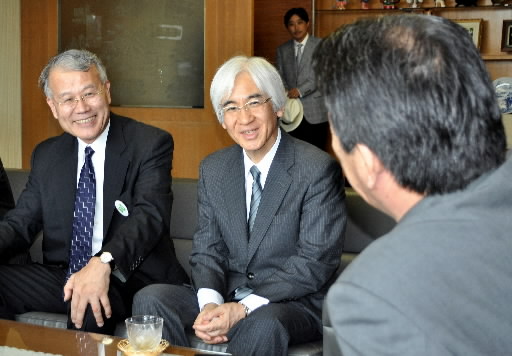Fukushima and Hiroshima: Impact on the A-bombed city, Part 3 [5]
Jul. 25, 2011
Article 5: The road ahead
by Seiji Shitakubo and Yo Kono, Staff Writers
Spotlight on A-bomb experiences
Every August 6, the anniversary of the atomic bombing, the mayor of Hiroshima delivers the Peace Declaration at the Peace Memorial Ceremony. Kazumi Matsui, the new mayor who took office in April, has expressed his desire to include A-bomb survivors' experiences and thoughts on peace in this year's declaration.
Reiko Okada, 81, a resident of Mihara, a city in Hiroshima Prefecture, felt so shocked by the disaster at the nuclear power plant in Fukushima that she took up her pen. Sixty-six years ago, Ms. Okada was exposed to residual radiation in Hiroshima while engaged in relief efforts for survivors of the blast. “The atomic bombing and nuclear power generation are identical as far as destroying human lives,” Ms. Okada said, reading out one of the passages contained in the message she had submitted to the mayor's office.
Unearthly nature of radiation
Before her retirement, Ms. Okada was an art teacher. In her art, she incorporated an anti-nuclear stance and a prayer for peace. She has never forgotten the fact that many survivors of the bombing died despite not having suffered major injuries in the blast. These deaths brought the unearthly nature of radiation home to her. “In Fukushima, too, many people are now horrified by the dangers of radiation,” Ms. Okada said. “Hiroshima must send a message to them.” She is eager to see how Mr. Matsui will include the Fukushima disaster in the Peace Declaration.
In late March, a committee charged with reviewing the exhibits at Hiroshima Peace Memorial Museum held a meeting. One member of this committee voiced the idea of instituting a museum for radiation exposure. This suggestion was made by Norioki Ishimaru, a professor of Architectonics at Hiroshima International University. Mr. Ishimaru stressed, “This is a critical moment for us. The Japanese people must be well prepared for the repercussions of an accident at a nuclear power plant.”
The plan to construct the Kaminoseki nuclear power plant, which the Chugoku Electric Company has been pursuing for a site in Kaminoseki, Yamaguchi Prefecture, has come under close scrutiny. Many of the municipal councils which surround the site have taken the position of canceling or freezing the project. The town of Sera, located in Hiroshima Prefecture and lying about 120 kilometers northeast of the planned site for the nuclear plant, also now opposes its construction.
In late June, the Sera Town Council, composed of 16 seats, voted to hold the position that “New construction or expansion of all nuclear power plants in Japan, including the plant in Kaminoseki, must be canceled,” arguing that “In the event of a nuclear power plant accident, radioactive materials will be spread widely” and “Agricultural areas like Sera will suffer significant damage.” The statement articulating this position was passed with 14 votes in favor and one vote against (with the chairperson exempted from the vote).
Isao Toyota, 70, who proposed the statement, emphasized, “The role of government is to protect the lives and property of the people without being bound by vested interests or past bonds.”
Support from Hiroshima University
Four months have passed since the nuclear accident took place. The disaster in Fukushima has had a ranging impact on the A-bombed city of Hiroshima.
On July 15, Kenji Kamiya, director of Hiroshima University’s Research Institute for Radiation and Medicine and an expert in radiation damage, assumed the post of vice president at Fukushima Medical University, located in the city of Fukushima, in a part-time capacity.
Hiroshima University has also concluded a comprehensive agreement with Fukushima University in which Hiroshima University intends to provide support to the people affected by the disaster in the areas of radiation medicine, the environment, and mental health. This support will be undertaken in cooperation with Fukushima University and Fukushima Medical University. With over 60 years having passed since the atomic bombing, Hiroshima University has indicated that its challenge also involves nurturing successors in the fields of peace and nuclear issues. A significant role for the university has arisen again.
(Originally published on July 18, 2011)








